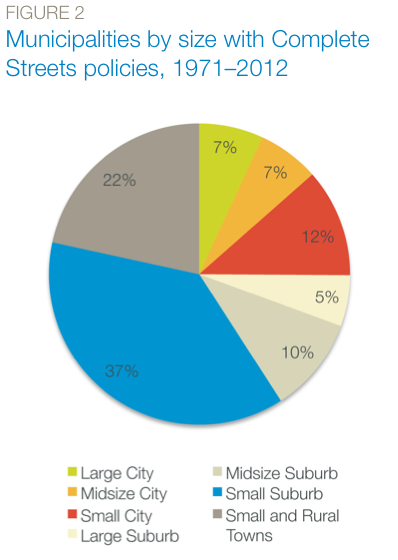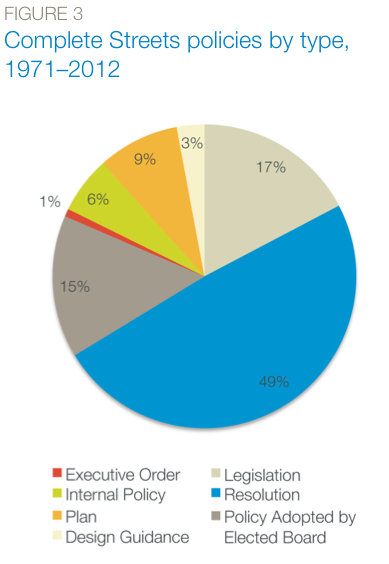SMART GROWTH AMERICA
Introduction
Communities of all sizes are transforming their streets into more than just a way to move people in cars from one place to another.
 These communities are part of a growing national movement for Complete Streets. This movement encourages and provides for the safe access to destinations for everyone, regardless of age, ability, income, ethnicity or how they travel.
These communities are part of a growing national movement for Complete Streets. This movement encourages and provides for the safe access to destinations for everyone, regardless of age, ability, income, ethnicity or how they travel.
The Complete Streets movement fundamentally redefines what a street is intended to do, what goals a transportation agency is going to meet and how a community will spend its transportation money. The Complete Streets approach breaks down the traditional separation between highways, transit, biking and walking, and instead focuses on the desired outcomes of a transportation system that supports safe use of the roadway for everyone.
The Complete Streets movement is powered by diverse alliances, bringing together advocates for older Americans, public health agencies, transportation practitioners, bicycling and walking advocates and many others. Policies have been adopted as part of public health campaigns to create friendly environments for healthy physical activity; as a way to address pressing safety concerns; and as one answer to the need to create more environmentally and economically sustainable communities.
What is a Complete Streets policy?
Complete Streets policies formalize a community’s intent to plan, design, operate and maintain streets so they are safe for all users of all ages and abilities. Policies direct decision-makers to consistently fund, plan, design and construct community streets to accommodate all anticipated users, including pedestrians, bicyclists, public transit users, motorists and freight vehicles.
The National Complete Streets Coalition recognizes many types of policy statements as official commitments to a Complete Streets approach, including legislation, resolutions, executive orders, departmental policies, policies adopted by an elected board, plans and design guidance.
Legislation legally requires the needs of all users to be addressed in transportation projects by changing city code, county code or state statutes. Resolutions are non-binding official statements from a jurisdiction’s legislative branch, and executive orders are issued by a jurisdiction’s executive branch. Departmental policies are issued by a jurisdiction’s transportation agency, office or department without formal approval from an elected body. Policies adopted by an elected board are usually developed by an internal group of stakeholders that are taken to the governing body and put before a vote. Some communities also incorporate Complete Streets in comprehensive or transportation plans or through updates to street design guidance. With the exception of these plans and guidance, this report analyzes all the policies described above.
Evaluating Complete Streets Policies
The concept of Complete Streets is simple and inspiring, but the best policies do more than simply affirm support for Complete Streets. Ideal policies refine a vision, provide clear direction and intent, complement community needs and grant the flexibility in design and approach necessary to secure an effective Complete Streets process and outcome.
The National Complete Streets Coalition promotes a comprehensive policy model that includes 10 ideal elements:
 1. Vision and intent: The policy outlines a vision for how and why the community wants to complete its streets.
1. Vision and intent: The policy outlines a vision for how and why the community wants to complete its streets.
2. All users and modes: The policy specifies that “all users” includes pedestrians, bicyclists and transit passengers of all ages and abilities, as well as trucks, buses and automobiles.
3. All projects and phases: Both new and retrofit projects are subject to the policy, including design, planning, maintenance and operations, for the entire right-of-way.
4. Clear, accountable exceptions: Any exceptions are specified and must be approved by a high-level official.
5. Network: The policy encourages street connectivity and creates a comprehensive, integrated and connected network for all modes across the network.
6. Jurisdiction: All other agencies can clearly understand the policy and may be involved in the process.
7. Design: The policy recommends the latest and best design criteria and guidelines, while recognizing the need for flexibility in balancing user needs.
8. Context sensitivity: Community context is considered in planning and design solutions.
9. Performance measures: Performance standards with measurable outcomes are included.
10. Implementation next steps: Specific next steps for implementing the policy are described.
These elements were developed in consultation with members of the National Complete Streets Coalition’s Steering Committee and its Workshop Instructor corps and through our ongoing research work. Based on decades of experience in transportation planning and design, the elements reflect a national model of best practice that can apply to nearly all types of Complete Streets policies at all levels of governance.
This report evaluates the language of Complete Streets policies based on the elements outlined above and recognizes those communities that have integrated best practices into customized documents. This report focuses on how well-written policy language adopted to date compares to the Coalition’s 10 elements of an ideal policy.
More information about the 10 elements are detailed in the Complete Streets Local Policy Workbook, a companion to this report. The workbook helps counties and cities examine current strategies and Complete Streets needs to develop locally appropriate language that draws from the best practices identified in this report.
Download full report (PDF) here: The Best Complete Streets Policies
About Smart Growth America
www.smartgrowthamerica.org
“Smart Growth America advocates for people who want to live and work in great neighborhoods. We believe smart growth solutions support businesses and jobs, provide more options for how people get around and make it more affordable to live near work and the grocery store. Our coalition works with communities to fight sprawl and save money. We are making America’s neighborhoods great together.”







 RSS Feed
RSS Feed